Examining Ethical Issues in Healthcare: A Case Study Analysis 2018
VerifiedAdded on 2023/06/13
|8
|2186
|260
Essay
AI Summary
This essay identifies and analyzes ethical issues arising from a case study involving a high school student, Amos, who was denied medical treatment based on his residential status. The analysis focuses on violations of human dignity, human rights, and professional codes of ethics, including the Hippocratic Oath and the principles of bioethics outlined in the Belmont Report. The paper discusses the importance of equality, patient rights, and the responsibilities of medical professionals to provide unbiased care, respect patient autonomy, and prioritize patient well-being. It concludes by emphasizing the roles of society, medical professionals, and the government in ensuring ethical practices and protecting patients from negligence and malpractice, while also highlighting the need for continuous education and skilled healthcare provision. Desklib provides access to similar solved assignments and past papers for students.
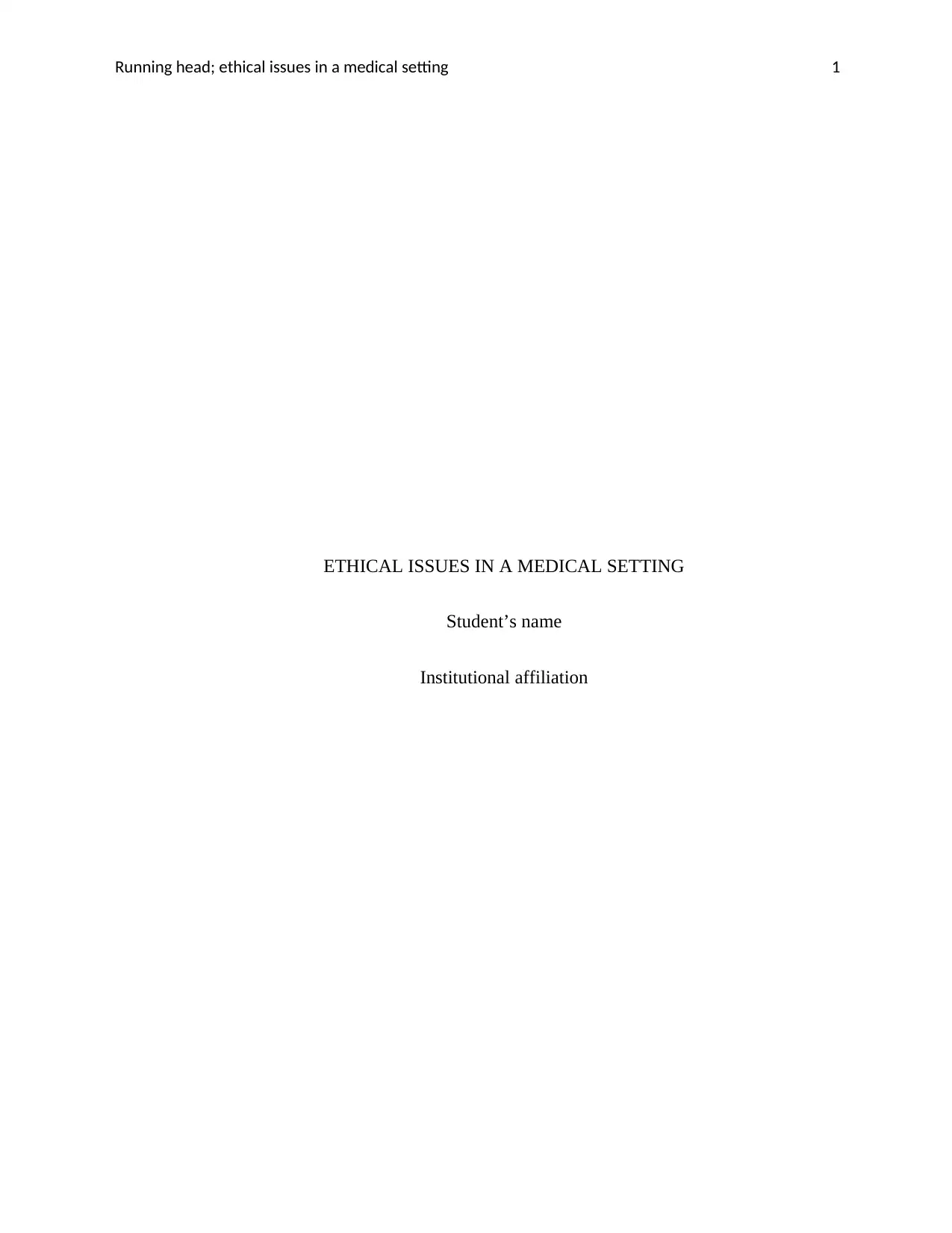
Running head; ethical issues in a medical setting 1
ETHICAL ISSUES IN A MEDICAL SETTING
Student’s name
Institutional affiliation
ETHICAL ISSUES IN A MEDICAL SETTING
Student’s name
Institutional affiliation
Paraphrase This Document
Need a fresh take? Get an instant paraphrase of this document with our AI Paraphraser
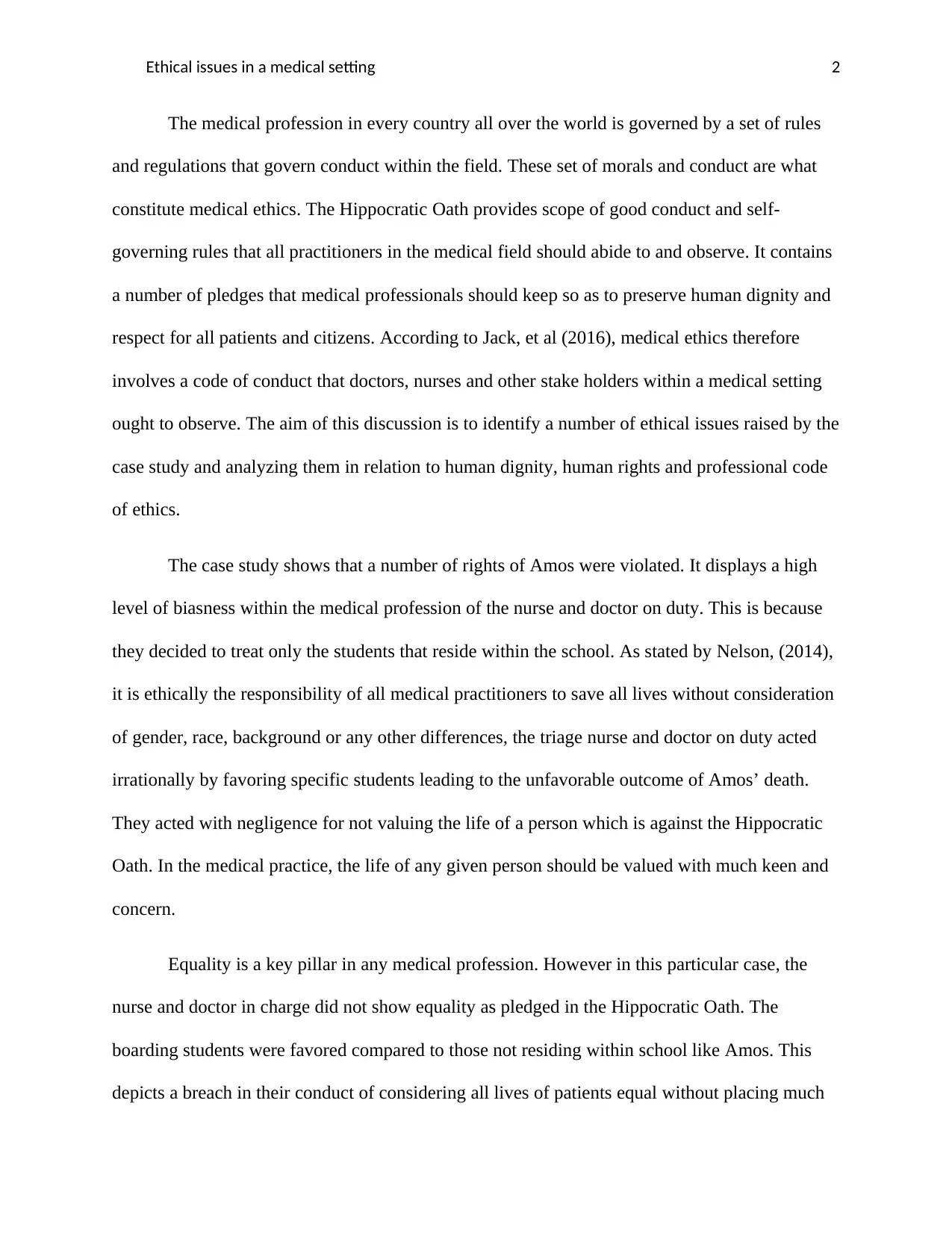
Ethical issues in a medical setting 2
The medical profession in every country all over the world is governed by a set of rules
and regulations that govern conduct within the field. These set of morals and conduct are what
constitute medical ethics. The Hippocratic Oath provides scope of good conduct and self-
governing rules that all practitioners in the medical field should abide to and observe. It contains
a number of pledges that medical professionals should keep so as to preserve human dignity and
respect for all patients and citizens. According to Jack, et al (2016), medical ethics therefore
involves a code of conduct that doctors, nurses and other stake holders within a medical setting
ought to observe. The aim of this discussion is to identify a number of ethical issues raised by the
case study and analyzing them in relation to human dignity, human rights and professional code
of ethics.
The case study shows that a number of rights of Amos were violated. It displays a high
level of biasness within the medical profession of the nurse and doctor on duty. This is because
they decided to treat only the students that reside within the school. As stated by Nelson, (2014),
it is ethically the responsibility of all medical practitioners to save all lives without consideration
of gender, race, background or any other differences, the triage nurse and doctor on duty acted
irrationally by favoring specific students leading to the unfavorable outcome of Amos’ death.
They acted with negligence for not valuing the life of a person which is against the Hippocratic
Oath. In the medical practice, the life of any given person should be valued with much keen and
concern.
Equality is a key pillar in any medical profession. However in this particular case, the
nurse and doctor in charge did not show equality as pledged in the Hippocratic Oath. The
boarding students were favored compared to those not residing within school like Amos. This
depicts a breach in their conduct of considering all lives of patients equal without placing much
The medical profession in every country all over the world is governed by a set of rules
and regulations that govern conduct within the field. These set of morals and conduct are what
constitute medical ethics. The Hippocratic Oath provides scope of good conduct and self-
governing rules that all practitioners in the medical field should abide to and observe. It contains
a number of pledges that medical professionals should keep so as to preserve human dignity and
respect for all patients and citizens. According to Jack, et al (2016), medical ethics therefore
involves a code of conduct that doctors, nurses and other stake holders within a medical setting
ought to observe. The aim of this discussion is to identify a number of ethical issues raised by the
case study and analyzing them in relation to human dignity, human rights and professional code
of ethics.
The case study shows that a number of rights of Amos were violated. It displays a high
level of biasness within the medical profession of the nurse and doctor on duty. This is because
they decided to treat only the students that reside within the school. As stated by Nelson, (2014),
it is ethically the responsibility of all medical practitioners to save all lives without consideration
of gender, race, background or any other differences, the triage nurse and doctor on duty acted
irrationally by favoring specific students leading to the unfavorable outcome of Amos’ death.
They acted with negligence for not valuing the life of a person which is against the Hippocratic
Oath. In the medical practice, the life of any given person should be valued with much keen and
concern.
Equality is a key pillar in any medical profession. However in this particular case, the
nurse and doctor in charge did not show equality as pledged in the Hippocratic Oath. The
boarding students were favored compared to those not residing within school like Amos. This
depicts a breach in their conduct of considering all lives of patients equal without placing much
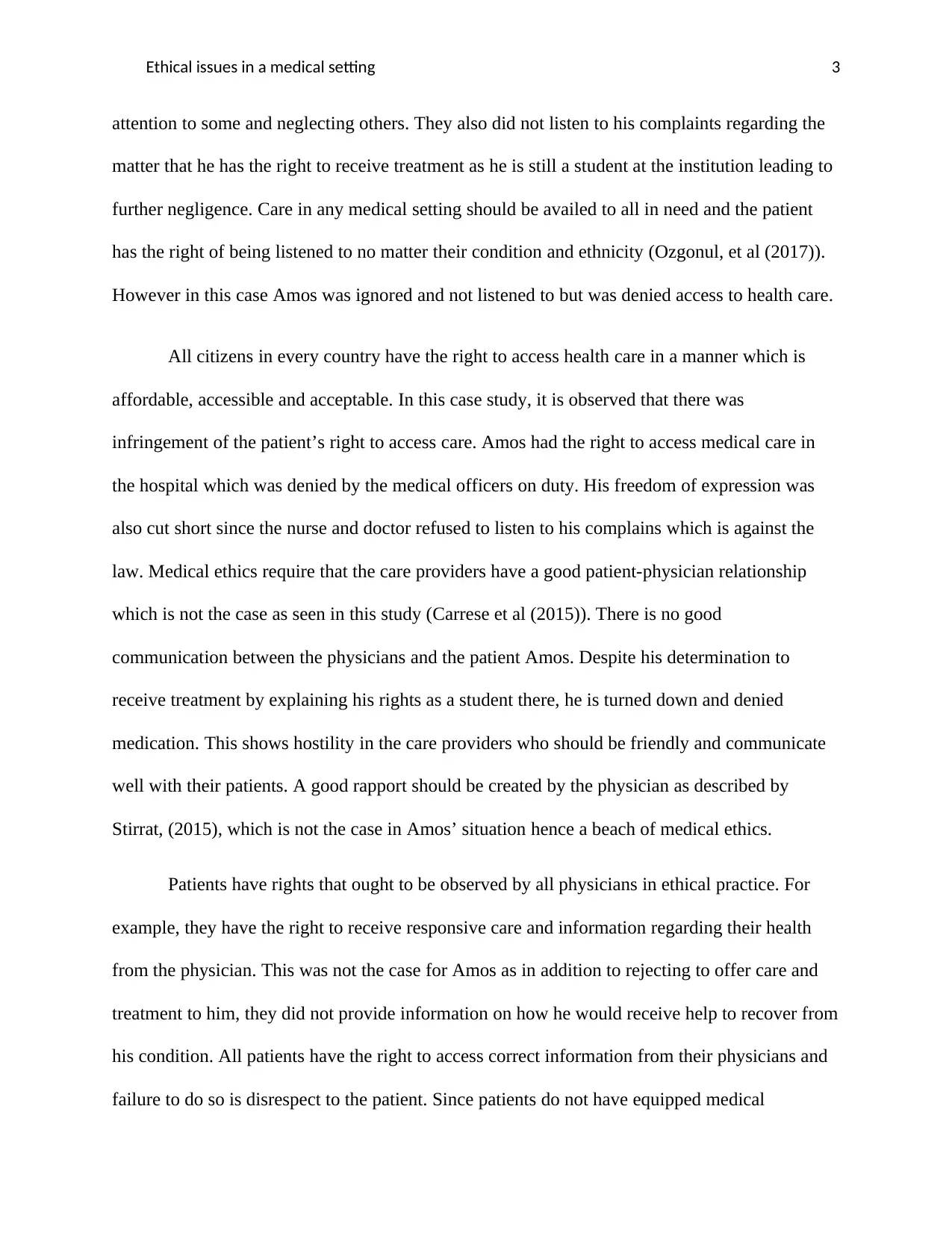
Ethical issues in a medical setting 3
attention to some and neglecting others. They also did not listen to his complaints regarding the
matter that he has the right to receive treatment as he is still a student at the institution leading to
further negligence. Care in any medical setting should be availed to all in need and the patient
has the right of being listened to no matter their condition and ethnicity (Ozgonul, et al (2017)).
However in this case Amos was ignored and not listened to but was denied access to health care.
All citizens in every country have the right to access health care in a manner which is
affordable, accessible and acceptable. In this case study, it is observed that there was
infringement of the patient’s right to access care. Amos had the right to access medical care in
the hospital which was denied by the medical officers on duty. His freedom of expression was
also cut short since the nurse and doctor refused to listen to his complains which is against the
law. Medical ethics require that the care providers have a good patient-physician relationship
which is not the case as seen in this study (Carrese et al (2015)). There is no good
communication between the physicians and the patient Amos. Despite his determination to
receive treatment by explaining his rights as a student there, he is turned down and denied
medication. This shows hostility in the care providers who should be friendly and communicate
well with their patients. A good rapport should be created by the physician as described by
Stirrat, (2015), which is not the case in Amos’ situation hence a beach of medical ethics.
Patients have rights that ought to be observed by all physicians in ethical practice. For
example, they have the right to receive responsive care and information regarding their health
from the physician. This was not the case for Amos as in addition to rejecting to offer care and
treatment to him, they did not provide information on how he would receive help to recover from
his condition. All patients have the right to access correct information from their physicians and
failure to do so is disrespect to the patient. Since patients do not have equipped medical
attention to some and neglecting others. They also did not listen to his complaints regarding the
matter that he has the right to receive treatment as he is still a student at the institution leading to
further negligence. Care in any medical setting should be availed to all in need and the patient
has the right of being listened to no matter their condition and ethnicity (Ozgonul, et al (2017)).
However in this case Amos was ignored and not listened to but was denied access to health care.
All citizens in every country have the right to access health care in a manner which is
affordable, accessible and acceptable. In this case study, it is observed that there was
infringement of the patient’s right to access care. Amos had the right to access medical care in
the hospital which was denied by the medical officers on duty. His freedom of expression was
also cut short since the nurse and doctor refused to listen to his complains which is against the
law. Medical ethics require that the care providers have a good patient-physician relationship
which is not the case as seen in this study (Carrese et al (2015)). There is no good
communication between the physicians and the patient Amos. Despite his determination to
receive treatment by explaining his rights as a student there, he is turned down and denied
medication. This shows hostility in the care providers who should be friendly and communicate
well with their patients. A good rapport should be created by the physician as described by
Stirrat, (2015), which is not the case in Amos’ situation hence a beach of medical ethics.
Patients have rights that ought to be observed by all physicians in ethical practice. For
example, they have the right to receive responsive care and information regarding their health
from the physician. This was not the case for Amos as in addition to rejecting to offer care and
treatment to him, they did not provide information on how he would receive help to recover from
his condition. All patients have the right to access correct information from their physicians and
failure to do so is disrespect to the patient. Since patients do not have equipped medical
⊘ This is a preview!⊘
Do you want full access?
Subscribe today to unlock all pages.

Trusted by 1+ million students worldwide
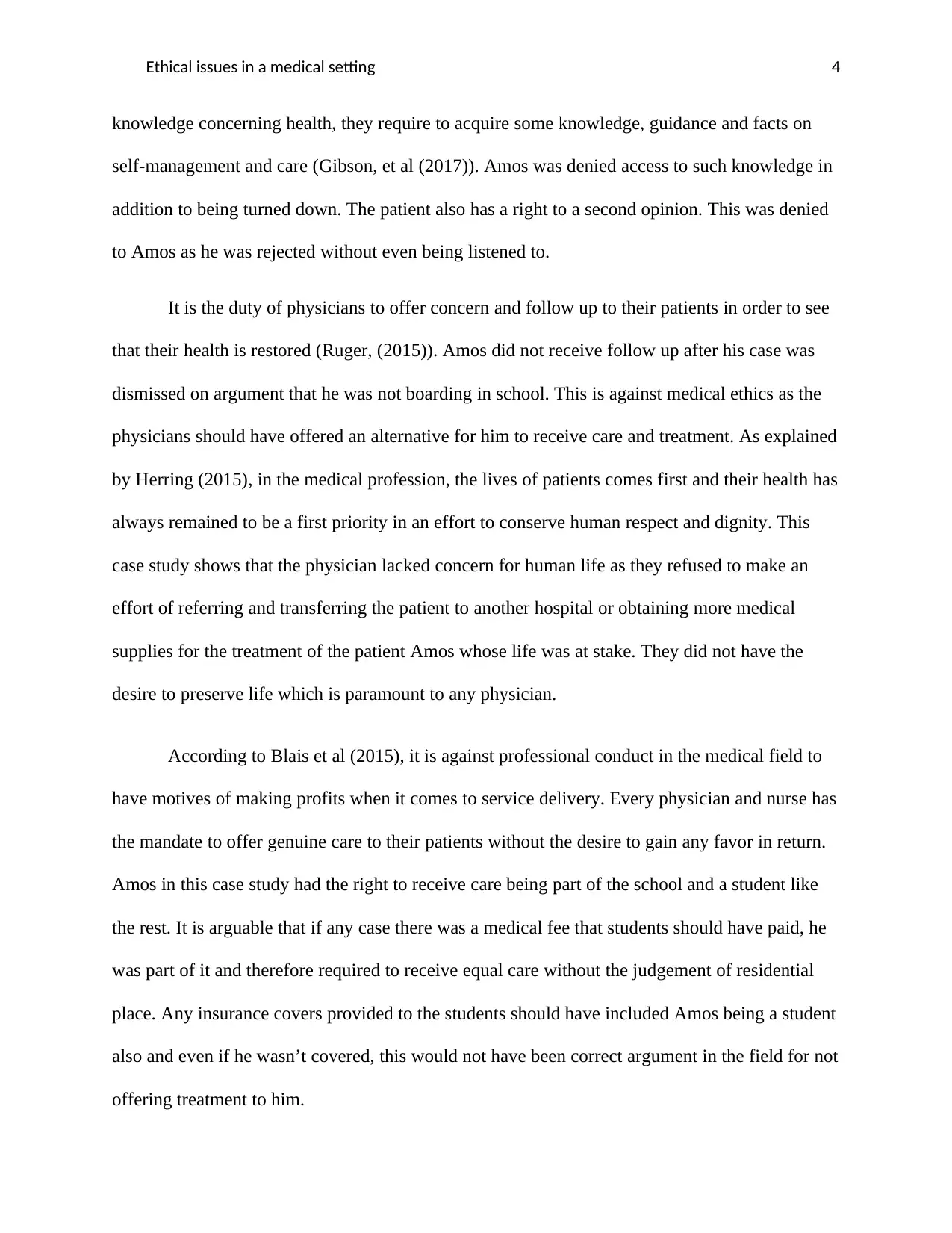
Ethical issues in a medical setting 4
knowledge concerning health, they require to acquire some knowledge, guidance and facts on
self-management and care (Gibson, et al (2017)). Amos was denied access to such knowledge in
addition to being turned down. The patient also has a right to a second opinion. This was denied
to Amos as he was rejected without even being listened to.
It is the duty of physicians to offer concern and follow up to their patients in order to see
that their health is restored (Ruger, (2015)). Amos did not receive follow up after his case was
dismissed on argument that he was not boarding in school. This is against medical ethics as the
physicians should have offered an alternative for him to receive care and treatment. As explained
by Herring (2015), in the medical profession, the lives of patients comes first and their health has
always remained to be a first priority in an effort to conserve human respect and dignity. This
case study shows that the physician lacked concern for human life as they refused to make an
effort of referring and transferring the patient to another hospital or obtaining more medical
supplies for the treatment of the patient Amos whose life was at stake. They did not have the
desire to preserve life which is paramount to any physician.
According to Blais et al (2015), it is against professional conduct in the medical field to
have motives of making profits when it comes to service delivery. Every physician and nurse has
the mandate to offer genuine care to their patients without the desire to gain any favor in return.
Amos in this case study had the right to receive care being part of the school and a student like
the rest. It is arguable that if any case there was a medical fee that students should have paid, he
was part of it and therefore required to receive equal care without the judgement of residential
place. Any insurance covers provided to the students should have included Amos being a student
also and even if he wasn’t covered, this would not have been correct argument in the field for not
offering treatment to him.
knowledge concerning health, they require to acquire some knowledge, guidance and facts on
self-management and care (Gibson, et al (2017)). Amos was denied access to such knowledge in
addition to being turned down. The patient also has a right to a second opinion. This was denied
to Amos as he was rejected without even being listened to.
It is the duty of physicians to offer concern and follow up to their patients in order to see
that their health is restored (Ruger, (2015)). Amos did not receive follow up after his case was
dismissed on argument that he was not boarding in school. This is against medical ethics as the
physicians should have offered an alternative for him to receive care and treatment. As explained
by Herring (2015), in the medical profession, the lives of patients comes first and their health has
always remained to be a first priority in an effort to conserve human respect and dignity. This
case study shows that the physician lacked concern for human life as they refused to make an
effort of referring and transferring the patient to another hospital or obtaining more medical
supplies for the treatment of the patient Amos whose life was at stake. They did not have the
desire to preserve life which is paramount to any physician.
According to Blais et al (2015), it is against professional conduct in the medical field to
have motives of making profits when it comes to service delivery. Every physician and nurse has
the mandate to offer genuine care to their patients without the desire to gain any favor in return.
Amos in this case study had the right to receive care being part of the school and a student like
the rest. It is arguable that if any case there was a medical fee that students should have paid, he
was part of it and therefore required to receive equal care without the judgement of residential
place. Any insurance covers provided to the students should have included Amos being a student
also and even if he wasn’t covered, this would not have been correct argument in the field for not
offering treatment to him.
Paraphrase This Document
Need a fresh take? Get an instant paraphrase of this document with our AI Paraphraser
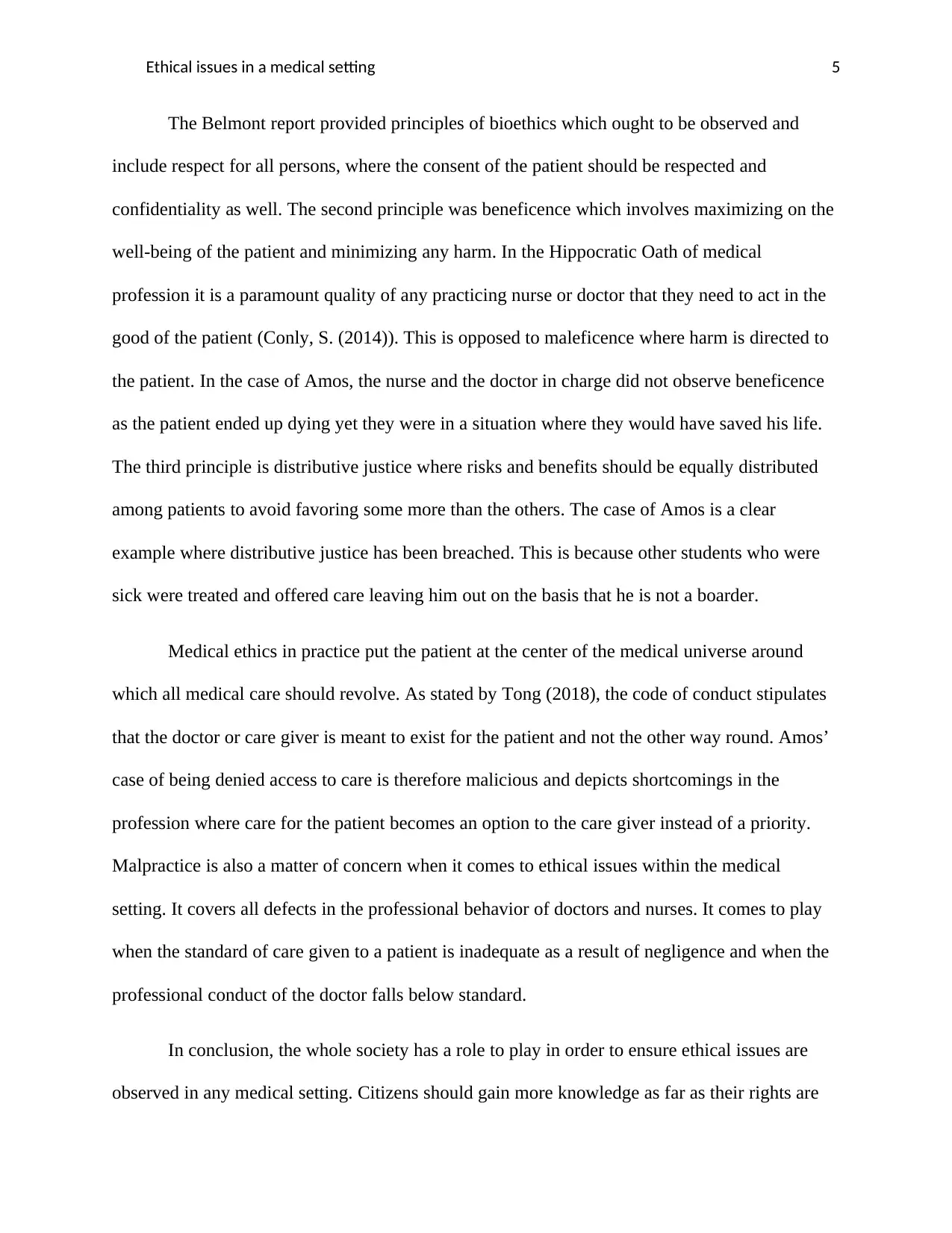
Ethical issues in a medical setting 5
The Belmont report provided principles of bioethics which ought to be observed and
include respect for all persons, where the consent of the patient should be respected and
confidentiality as well. The second principle was beneficence which involves maximizing on the
well-being of the patient and minimizing any harm. In the Hippocratic Oath of medical
profession it is a paramount quality of any practicing nurse or doctor that they need to act in the
good of the patient (Conly, S. (2014)). This is opposed to maleficence where harm is directed to
the patient. In the case of Amos, the nurse and the doctor in charge did not observe beneficence
as the patient ended up dying yet they were in a situation where they would have saved his life.
The third principle is distributive justice where risks and benefits should be equally distributed
among patients to avoid favoring some more than the others. The case of Amos is a clear
example where distributive justice has been breached. This is because other students who were
sick were treated and offered care leaving him out on the basis that he is not a boarder.
Medical ethics in practice put the patient at the center of the medical universe around
which all medical care should revolve. As stated by Tong (2018), the code of conduct stipulates
that the doctor or care giver is meant to exist for the patient and not the other way round. Amos’
case of being denied access to care is therefore malicious and depicts shortcomings in the
profession where care for the patient becomes an option to the care giver instead of a priority.
Malpractice is also a matter of concern when it comes to ethical issues within the medical
setting. It covers all defects in the professional behavior of doctors and nurses. It comes to play
when the standard of care given to a patient is inadequate as a result of negligence and when the
professional conduct of the doctor falls below standard.
In conclusion, the whole society has a role to play in order to ensure ethical issues are
observed in any medical setting. Citizens should gain more knowledge as far as their rights are
The Belmont report provided principles of bioethics which ought to be observed and
include respect for all persons, where the consent of the patient should be respected and
confidentiality as well. The second principle was beneficence which involves maximizing on the
well-being of the patient and minimizing any harm. In the Hippocratic Oath of medical
profession it is a paramount quality of any practicing nurse or doctor that they need to act in the
good of the patient (Conly, S. (2014)). This is opposed to maleficence where harm is directed to
the patient. In the case of Amos, the nurse and the doctor in charge did not observe beneficence
as the patient ended up dying yet they were in a situation where they would have saved his life.
The third principle is distributive justice where risks and benefits should be equally distributed
among patients to avoid favoring some more than the others. The case of Amos is a clear
example where distributive justice has been breached. This is because other students who were
sick were treated and offered care leaving him out on the basis that he is not a boarder.
Medical ethics in practice put the patient at the center of the medical universe around
which all medical care should revolve. As stated by Tong (2018), the code of conduct stipulates
that the doctor or care giver is meant to exist for the patient and not the other way round. Amos’
case of being denied access to care is therefore malicious and depicts shortcomings in the
profession where care for the patient becomes an option to the care giver instead of a priority.
Malpractice is also a matter of concern when it comes to ethical issues within the medical
setting. It covers all defects in the professional behavior of doctors and nurses. It comes to play
when the standard of care given to a patient is inadequate as a result of negligence and when the
professional conduct of the doctor falls below standard.
In conclusion, the whole society has a role to play in order to ensure ethical issues are
observed in any medical setting. Citizens should gain more knowledge as far as their rights are

Ethical issues in a medical setting 6
concerned to ensure they are protected from negligence and medical malpractice. Medical
professionals on the other hand have a big role in observing proper conduct and following the
rules and laws governing their profession to avoid harm to patients. They should also be well
knowledgeable and skilled to offer genuine and correct treatment to patients by going through
acknowledged institutions of learning and passing their exams. The government has a role as
well in protecting the rights of its patients and offering regulation to the practice (Coleman
(2015)). Licenses should be offered to only skilled people so as to provide accurate and skilled
health care among citizens.
concerned to ensure they are protected from negligence and medical malpractice. Medical
professionals on the other hand have a big role in observing proper conduct and following the
rules and laws governing their profession to avoid harm to patients. They should also be well
knowledgeable and skilled to offer genuine and correct treatment to patients by going through
acknowledged institutions of learning and passing their exams. The government has a role as
well in protecting the rights of its patients and offering regulation to the practice (Coleman
(2015)). Licenses should be offered to only skilled people so as to provide accurate and skilled
health care among citizens.
⊘ This is a preview!⊘
Do you want full access?
Subscribe today to unlock all pages.

Trusted by 1+ million students worldwide
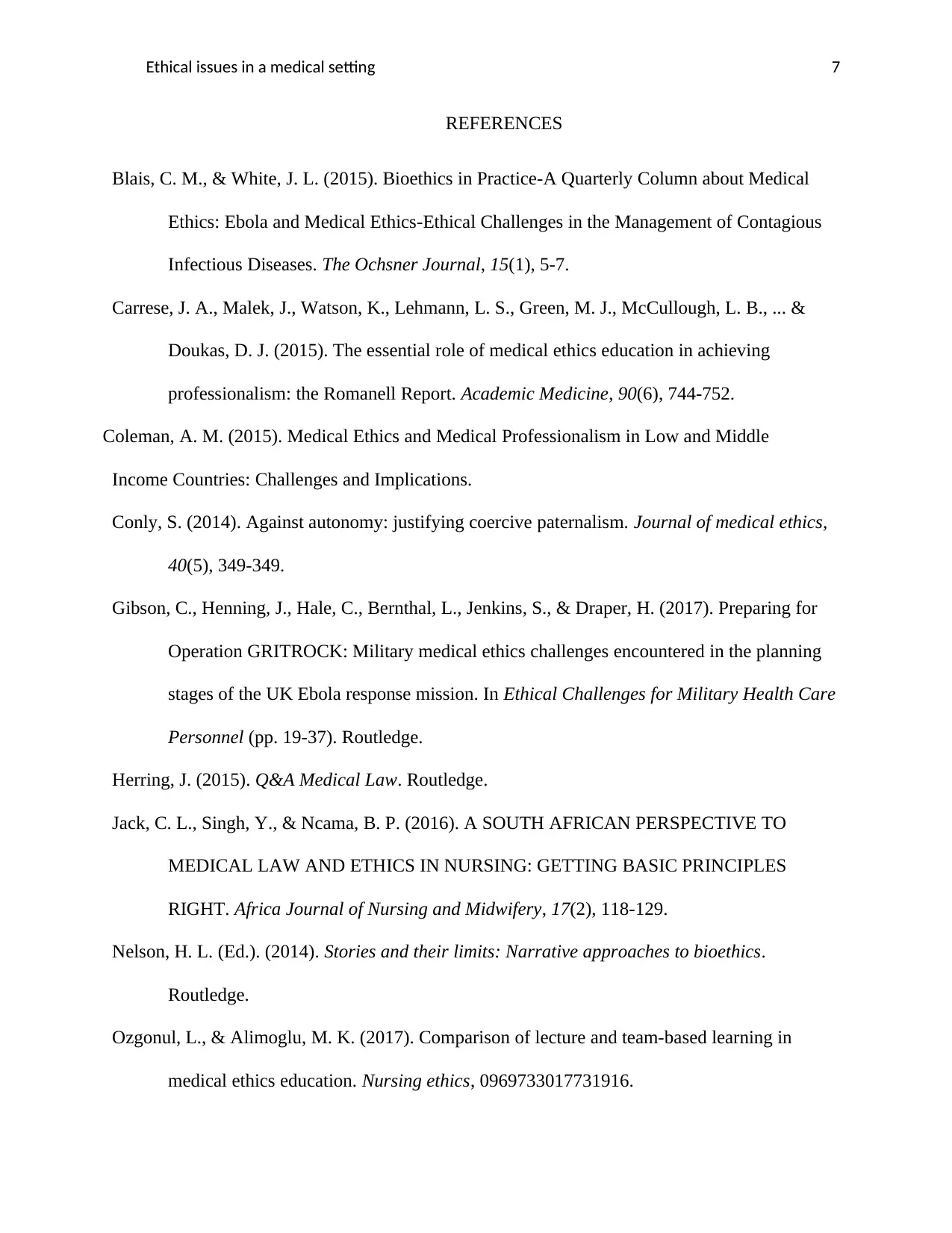
Ethical issues in a medical setting 7
REFERENCES
Blais, C. M., & White, J. L. (2015). Bioethics in Practice-A Quarterly Column about Medical
Ethics: Ebola and Medical Ethics-Ethical Challenges in the Management of Contagious
Infectious Diseases. The Ochsner Journal, 15(1), 5-7.
Carrese, J. A., Malek, J., Watson, K., Lehmann, L. S., Green, M. J., McCullough, L. B., ... &
Doukas, D. J. (2015). The essential role of medical ethics education in achieving
professionalism: the Romanell Report. Academic Medicine, 90(6), 744-752.
Coleman, A. M. (2015). Medical Ethics and Medical Professionalism in Low and Middle
Income Countries: Challenges and Implications.
Conly, S. (2014). Against autonomy: justifying coercive paternalism. Journal of medical ethics,
40(5), 349-349.
Gibson, C., Henning, J., Hale, C., Bernthal, L., Jenkins, S., & Draper, H. (2017). Preparing for
Operation GRITROCK: Military medical ethics challenges encountered in the planning
stages of the UK Ebola response mission. In Ethical Challenges for Military Health Care
Personnel (pp. 19-37). Routledge.
Herring, J. (2015). Q&A Medical Law. Routledge.
Jack, C. L., Singh, Y., & Ncama, B. P. (2016). A SOUTH AFRICAN PERSPECTIVE TO
MEDICAL LAW AND ETHICS IN NURSING: GETTING BASIC PRINCIPLES
RIGHT. Africa Journal of Nursing and Midwifery, 17(2), 118-129.
Nelson, H. L. (Ed.). (2014). Stories and their limits: Narrative approaches to bioethics.
Routledge.
Ozgonul, L., & Alimoglu, M. K. (2017). Comparison of lecture and team-based learning in
medical ethics education. Nursing ethics, 0969733017731916.
REFERENCES
Blais, C. M., & White, J. L. (2015). Bioethics in Practice-A Quarterly Column about Medical
Ethics: Ebola and Medical Ethics-Ethical Challenges in the Management of Contagious
Infectious Diseases. The Ochsner Journal, 15(1), 5-7.
Carrese, J. A., Malek, J., Watson, K., Lehmann, L. S., Green, M. J., McCullough, L. B., ... &
Doukas, D. J. (2015). The essential role of medical ethics education in achieving
professionalism: the Romanell Report. Academic Medicine, 90(6), 744-752.
Coleman, A. M. (2015). Medical Ethics and Medical Professionalism in Low and Middle
Income Countries: Challenges and Implications.
Conly, S. (2014). Against autonomy: justifying coercive paternalism. Journal of medical ethics,
40(5), 349-349.
Gibson, C., Henning, J., Hale, C., Bernthal, L., Jenkins, S., & Draper, H. (2017). Preparing for
Operation GRITROCK: Military medical ethics challenges encountered in the planning
stages of the UK Ebola response mission. In Ethical Challenges for Military Health Care
Personnel (pp. 19-37). Routledge.
Herring, J. (2015). Q&A Medical Law. Routledge.
Jack, C. L., Singh, Y., & Ncama, B. P. (2016). A SOUTH AFRICAN PERSPECTIVE TO
MEDICAL LAW AND ETHICS IN NURSING: GETTING BASIC PRINCIPLES
RIGHT. Africa Journal of Nursing and Midwifery, 17(2), 118-129.
Nelson, H. L. (Ed.). (2014). Stories and their limits: Narrative approaches to bioethics.
Routledge.
Ozgonul, L., & Alimoglu, M. K. (2017). Comparison of lecture and team-based learning in
medical ethics education. Nursing ethics, 0969733017731916.
Paraphrase This Document
Need a fresh take? Get an instant paraphrase of this document with our AI Paraphraser
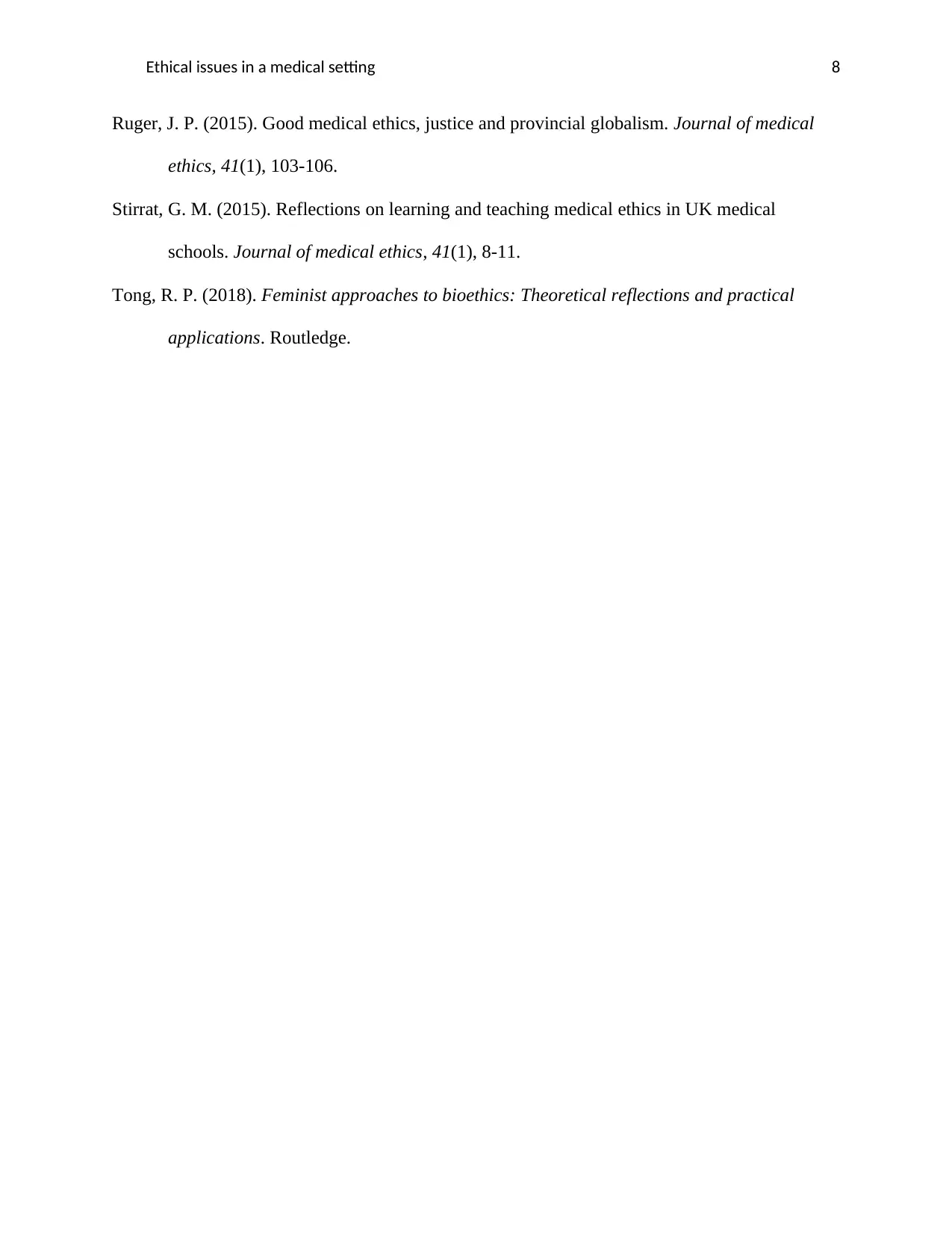
Ethical issues in a medical setting 8
Ruger, J. P. (2015). Good medical ethics, justice and provincial globalism. Journal of medical
ethics, 41(1), 103-106.
Stirrat, G. M. (2015). Reflections on learning and teaching medical ethics in UK medical
schools. Journal of medical ethics, 41(1), 8-11.
Tong, R. P. (2018). Feminist approaches to bioethics: Theoretical reflections and practical
applications. Routledge.
Ruger, J. P. (2015). Good medical ethics, justice and provincial globalism. Journal of medical
ethics, 41(1), 103-106.
Stirrat, G. M. (2015). Reflections on learning and teaching medical ethics in UK medical
schools. Journal of medical ethics, 41(1), 8-11.
Tong, R. P. (2018). Feminist approaches to bioethics: Theoretical reflections and practical
applications. Routledge.
1 out of 8
Related Documents
Your All-in-One AI-Powered Toolkit for Academic Success.
+13062052269
info@desklib.com
Available 24*7 on WhatsApp / Email
![[object Object]](/_next/static/media/star-bottom.7253800d.svg)
Unlock your academic potential
Copyright © 2020–2025 A2Z Services. All Rights Reserved. Developed and managed by ZUCOL.





